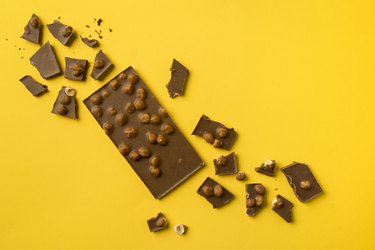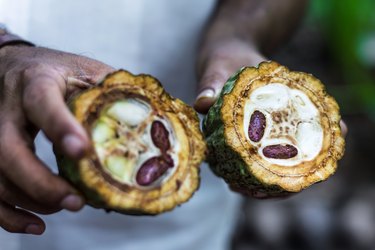
Livestrong.com may earn compensation through affiliate links in this story. Learn more about our affiliate and product review process here.

Choosing chocolate bars that are ethically sourced and Fair Trade Certified ensures that cocoa farmers are being properly compensated.
Image Credit: LightFieldStudios/iStock/GettyImagesFor many Americans, eating a chocolate bar is a relatively cheap and easy way to satisfy a sweet tooth. And chocolate's ubiquity — you can find it in convenience stores, pharmacies and online — means it's not hard to get your hands on when a craving calls.
But in other parts of the world, chocolate is considered an extravagance, Mary Linnell-Simmons, Fairtrade America's director of marketing, tells LIVESTRONG.com. Fairtrade America is a non-profit organization that works directly with companies to ensure that farmers and workers in developing countries are given a fair deal in growing their goods.
Video of the Day
Video of the Day
"It comes down to poverty," Linnell-Simmons explains. "Some of the lowest-paid farmers are operating in West Africa and growing cocoa, which is still considered a luxury item. To keep up with demand from chocolate companies and cut costs, these farmers are resorting to drastic measures, such as child labor," she says.
More than 70 percent of the world's cocoa comes from countries in Western Africa, such as Ghana, the Ivory Coast and Cameroon, where farmers are often paid very little for their crop, according to the International Food Information Council. As a result, farmers sometimes rely on child labor to increase their productivity and save operational costs.
Unfortunately, the use of child labor in cocoa farms has been a decades-long issue.
"A child should be in school, but their family owns a cocoa farm and needs help," Linnell-Simmons says. "Instead of going to school, they go to the cocoa farm. Farmers are making these difficult decisions about the future of their children."
Fairtrade America says it's not uncommon for cocoa farmers to receive only one paycheck a year, which they must allot for household and farm costs, equipment, schooling and other necessities.
Green America, a non-profit organization dedicated to promoting social justice and environmental health in the marketplace, reports that 60 percent of cocoa farmers earn less than $2 a day.
Third-party organizations like Fairtrade America help keep chocolate companies accountable.
Fairtrade will audit the full supply chain, ensuring that buyers aren't getting more product than what they paid for. "We only certify family farms and smaller farms — not mega-estate plantations," Linnell-Simmons says. "These farmers join a cooperative, and we will audit for our farm-level standards."
These standards include:
"We step in to make sure cocoa farmers get what they deserve. We have a baseline program for cocoa farmers to help them get out of the cycle of poverty," says Linnell-Simmons, explaining that the organization sets a fair trade minimum price and a fair trade premium to ensure crop-growers are justly compensated.
"Vote with your wallet and put money where your values are. Chocolate is not as convenient and cheap as you might think."
The fair trade minimum price is essentially the floor price chocolate companies must pay to do business with a cocoa cooperative, says Linnell-Simmons. This price covers the costs of the sustainable production, which includes labor, fertilizers, pesticides, seeds, water and processing and export costs.
The fair trade premium is an additional amount paid in a lump sum by chocolate companies. Cooperative members decide how to spend the money from the fair trade premium. Farmers might put it toward paying for education, community services or healthcare.
"A community might need a medical facility, for instance, so the fair trade premium can go toward paying for the costs of building one," Linnell-Simmons says.

Real cocoa doesn't start out looking like a chocolate bar; it comes from the seeds of cocoa fruits, which grow on cocoa trees.
Image Credit: BestForBest/iStock/GettyImagesIt's important to note that while Fairtrade's farming standards prohibit child labor, the certification system won't absolutely guarantee that a product is completely free of child labor.
Fairtrade can only promise that if a farm violates child labor rules, they will work to protect the child and work with the farmers to ensure it doesn't happen again. Fairtrade also encourages farmers to follow sustainable farming practices, but it doesn't mandate all specific practices.
"We ban the use of GMO seeds and advocate for farmers to follow better practices whenever possible. We don't say, 'you must grow organic,' but if a farmer chooses to do organic farming, we support them and enable them to learn from each other," Linnell-Simmons says.
There's also an emphasis on sharing. If one farmer discovers a sustainable farming technique that increases their productivity and yield, Fairtrade helps them share it with other farmers in their cooperative.
Fairtrade also promotes complementary crop farming, which focuses on symbiotic techniques, like keeping bees to sell honey at fair trade while pollinating their crops.
Ultimately, people can help cocoa farmers by educating themselves about the source of their chocolate while buying from food companies that ethically source their cocoa. You can also ask your local grocery stores to carry more fair trade products, including chocolate.
"Most people like chocolate, but don't know what a cocoa plant looks like or where it grows. Getting more aware and learning more about what it looks like and where it grows can help you understand where it comes from," Linnell-Simmons says.
"Vote with your wallet and put money where your values are. Chocolate is not as convenient and cheap as you might think."
Some chocolate companies will deceptively claim to be fair trade while they are not actually ethically sourced. To ensure you're truly buying fair trade chocolate, make sure to look for these approved fair trade labels on products.
Fair trade labels are nuanced, if not a little confusing, so read the label descriptions carefully to ensure that you're buying a product you intended to purchase.
For example, the Fair Trade Certification mark certifies that all ingredients in the product are from fair trade sources. On the other hand, the Fair Trade Certified label means that only the cocoa in the product is certified fair trade.
"The product packaging is a great place to review the ingredient statement and nutrition and allergen information of a product," Candace Pumper, RD, LD, a dietitian at the Ohio State University Wexner Medical Center, tells LIVESTRONG.com. "Higher-quality fair trade chocolate products will have the fewest ingredients with cacao beans and cocoa mass (chocolate liquor) listed first."
Pumper says you might also see different forms of cocoa listed, such as cocoa nibs, cacao butter and cacao powder. (Other ingredients include cane sugar, coconut sugar, inulin, milk fat or powder, lecithin and vanilla pods or vanilla extract.)
To help you choose the healthiest fair trade dark chocolate bars, here are some of Pumper's tips: